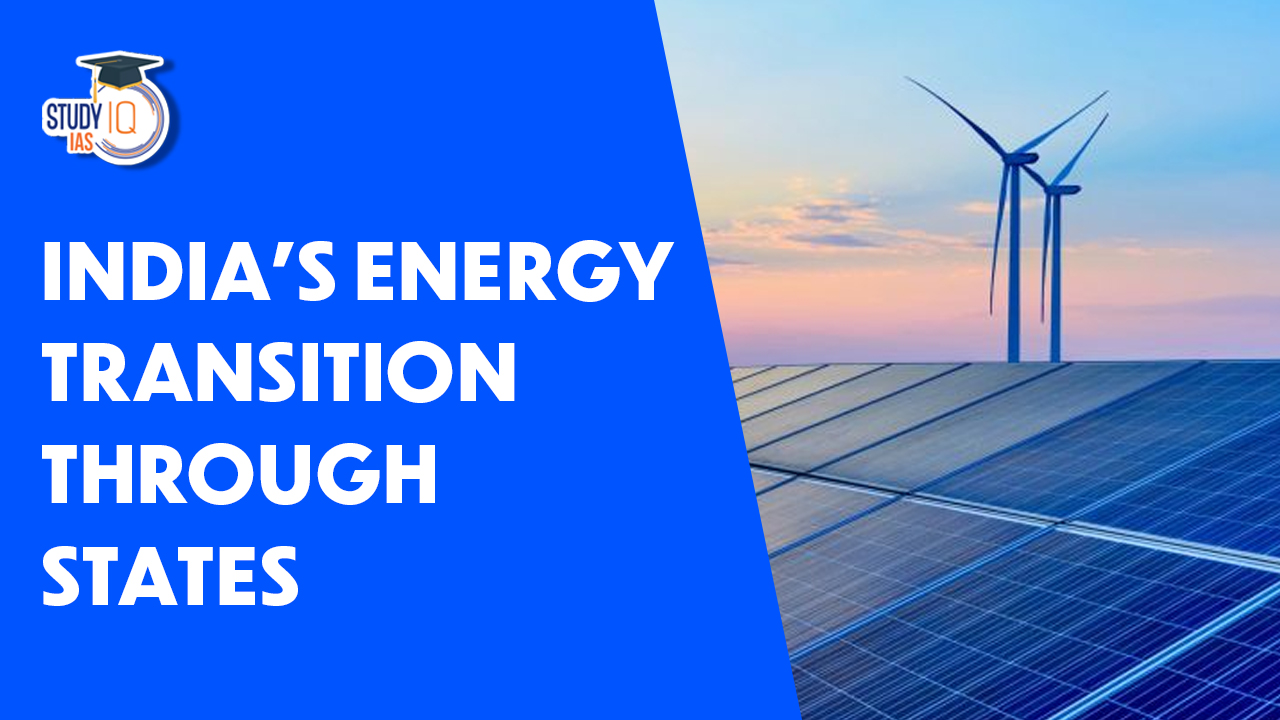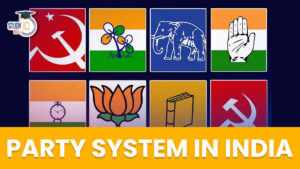Table of Contents
Context: The diversity of India’s States necessitates multiple pathways to determine its own domestic energy transition.
India’s Energy Transition through States Background
- In the upcoming G20 forum, India shall propose a multiple energy pathways approach to accommodate diverse contexts and development trajectories of countries.
- India’s global climate pledges, 50% non-fossil electricity generation capacity by 2030 and net-zero emissions by 2070, are backed by domestic energy targets at the national level.
- Against such a backdrop, it becomes imperative that States in India become an active participant towards achieving these targets.
What is meant by Energy Transition?
- Definition: Energy transition means a shift in the energy sector’s shift from fossil-based systems of energy production and consumption to renewable energy sources like wind and solar, as well as lithium-ion batteries.
- Significance: As a rapidly developing nation, India is currently the world’s fourth-largest GHG emitter.
- Solar, wind, and other renewable energy (RE) sources are already replacing the historic share of coal and gas in the power generation mix.
- Key Drivers: The increasing penetration of renewable energy into the energy supply mix, the onset of electrification and improvements in energy storage are all key drivers of the energy transition.
- Method: Transforming the energy system can be achieved by:
- Ensuring the efficient use of energy across sectors.
- Innovation, recycling, and circular economy.
Role of States in India’s Energy Transition
- To meet India’s Nationally Determined Contribution targets, the centre and states must play a crucial role.
- In a federal setting, States matter for four functions critical to energy transition:
- Spheres of Implementation: States as spheres of implementation are critical to the realization of national targets. As the Centre may set goals, the realization of these goals often depends on states.
- Addressal of Issues: The issues in the electricity sector, such as high losses, unreliable supply and service quality are addressed at the State level.
- Policy Innovations: States as laboratories of policy innovations have been instrumental to India’s energy transition.
- State Priorities: States can also be roadblocks to national goals if the goals are perceived to be misaligned with State priorities.
How Prepared are States for Energy Transition?
- The Institute for Energy Economics and Financial Analysis (IEEFA) and Ember recently released a report titled “Indian States’ Energy Transition“.
- The report analyzed 16 states that account for 90% of India’s yearly power demand. Their scores were calculated based on states’ performance on four major dimensions:
- Decarbonisation
- Performance of the Power System
- Readiness of the Power Ecosystem
- Policies and Political Commitments.
- The report found that Renewable Energy installations are majorly concentrated (up to 78%) only in Karnataka, Tamil Nadu, Gujarat, Rajasthan, Maharashtra, and Andhra Pradesh.
- Karnataka: Karnataka is the only state that scored well across all four dimensions. Karnataka has been an early adopter of renewable energy and also has the highest share of renewables in its power supply mix (48%).
- Rajasthan: It has renewables supplying 29% of the state’s power mix. In March 2022, it became the state with the largest installed capacity of renewable energy.
- Haryana: It has the lowest installed capacity of older, more polluting coal power plants.
- Maharashtra: It has the highest power demand in India but has been slow in renewable energy uptake. It has not shut down older polluting coal power plants. Its renewable energy share (11%) is lower than most other states.
- Bihar, UP and West Bengal: These states scored low on most parameters. They have to strengthen their clean electricity transition performances. These states should maximise their renewable energy generation potential and move away from fossil fuels-based electricity.

- Recommendation in the Report:
- Focus on Offshore Wind Energy: India has the potential to generate 140GW of electricity from offshore wind along its 7,600km coastline.
- Coal Plants: State energy departments need to closely monitor their coal plants and retire older plants.
- Green Market Participation of States: States need to focus on increasing participation in green market mechanisms like Green Day Ahead Market (GDAM), Green Term Ahead Market (GTAM) open access.
- Private Sector Participation: The introduction of private sector participation and competition shall bring more capital and management expertise into the electricity sector.
- Feeder Segregation: Reliable state-level data on feeder segregation needs to be made available for more robust analysis.
- Circular Approach: States need to develop a holistic and circular approach towards handling solar panel, battery, and electric vehicle waste.
Initiatives by States to Facilitate Energy Transition
- The Interstate Clean Energy Procurement Program (ICEPP) was launched in India by the U.S. Trade and Development Agency (USTDA).
- ICEPP will help eight Indian states build up their clean energy infrastructure by giving public procurement officials training on best value and life-cycle cost analysis.
- Rajasthan: Rajasthan Wind Solar Hybrid Policy 2019 and Rajasthan Electric Vehicle Policy 2022 helped accelerate the capacity addition.
- Karnataka: It was the first southern state in India to notify a renewable energy policy, the Karnataka Renewable Energy Policy 2009-14 to harness green, clean, renewable energy sources for environmental benefits and energy security.
- Tamil Nadu: It has a dedicated solar energy policy 2019 and Electric Vehicle (EV) Policy 2019.
Challenges Faced by States in Energy Transition
- Under-utilization: Renewable energy-rich states are not utilizing their renewable energy generation potential.
- Potential hurdles, such as land conflict, technology upgrades, and lack of transmission infrastructure obstruct the clean energy transition of states.
- Ignorance of other Avenues: While the states are focusing on large-scale renewable power projects, mainly utility-scale solar, they are ignoring other possibly viable options, such as rooftop solar, small hydel plants, etc.
- Mismatched Priorities: The Union Government and State Governments in India often have different priorities with respect to the energy sector.
- The Centre’s perspective is informed by macroeconomic stability, economic growth and geostrategic issues.
- Energy Transition at the State Level and Fiscal Impact: Many coal-producing states naturally rely heavily on fossil fuels for revenues as they benefit from both coal-related royalties from mining but also tax revenues from sales of oil and natural gas.
- Impact on State’s Employment: As India moves away from fossil fuels, there will be negative effects on jobs all along the value chain.
- This includes employment across mining, transport and storage, processing and manufacturing, and trade.
Potential Solutions to Facilitate Energy Transition in States
- Bridging the Gap: An effective transition will require bridging the ambitions and implementation gaps between the Centre and the States.
- National ambitions need to factor the varying incentive structures, processes, and institutional capacities at the State level.
- Analyzing Capabilities of States: India has set laudable goals for its energy transition. In this context, there needs to be engagement with States with respect to cross-sectoral inter-linkages, constraints, and opportunities for transition.
- Multi-scalar Planning & Execution: An effective transition requires multi-scalar planning and execution strategy.
- Whether State targets add up to meet national goals
- Managing renewable energy-enabled load migration
- Changing role of institutions and how these will affect legacy issues
- Resources required to deal with these implications.
- States to be engaged in Policies & Plans: States are important entry points to engage with policy visions, plans and actions.
- Central agencies have also developed multiple indexes that rank States on different aspects of energy transition. There is a need to complement this with analysis of State-level preparedness for energy transition.
- A State-level Framework: There is a need for a State-level framework to understand plans, actions, and governance processes towards an energy transition.
- Such framework will help to broaden the transition discourse from outcomes and to include the processes that shape the outcomes.
- A State-level framework can enable more evidence-based policy choices towards a pragmatic, yet accelerated, scale and pace of energy transition.


 Custodial Deaths in India, Types, Issues...
Custodial Deaths in India, Types, Issues...
 MPPSC FSO Recruitment Notification 2025 ...
MPPSC FSO Recruitment Notification 2025 ...
 Party System in India, Feature, Importan...
Party System in India, Feature, Importan...





















